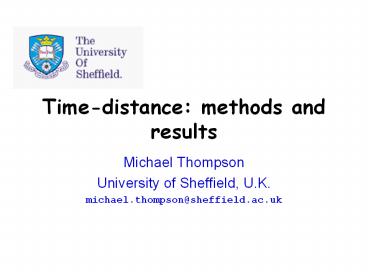Time-distance: methods and results - PowerPoint PPT Presentation
Title:
Time-distance: methods and results
Description:
Measures travel times of acoustic or surface gravity waves propagating between ... Deep focussing. Point-to-point. Line-point. Choice of geometry as an inverse problem ... – PowerPoint PPT presentation
Number of Views:21
Avg rating:3.0/5.0
Title: Time-distance: methods and results
1
Time-distance methods and results
- Michael Thompson
- University of Sheffield, U.K.
- michael.thompson_at_sheffield.ac.uk
2
Time-distance helioseismology
- Measures travel times of acoustic or surface
gravity waves propagating between different
surface points through the interior. The travel
times depend on conditions, flow velocity and
sound speed along the ray path
Analysis proceeds by calculating
cross-correlation of signal at different points
on the surface
3
Three generic steps
- Filter the data
- Average the data (e.g. over an annulus and over a
small central region) - Compute the cross-covariance (e.g. of the annular
signal with the central signal)
4
Spatial averaging
- Choices of geometries
- Centre-annulus
- possibly divided into quadrants
- Point to arc
- Deep focussing
- Point-to-point
- Line-point
- . . . . . .
5
Choice of geometry as an inverse problem
6
Filtering
- Phase-speed filtering
- Filtering different modes
- Frequency filtering
- Choice of filters and filter parameters
7
T-D seismology around ARs
Courtesy of A. Kosovichev
8
Structure under ARs 10486 and 10488, October 31,
2003, 1200 UT
AR 10488
9
Comparing old and new sunspots
10
(No Transcript)
11
(No Transcript)
12
Asymmetric cross-correlation near active regions
13
Mean travel-time perturbation
E-W travel-time perturbation
S-N travel-time perturbation
Magnetogram
Amplitude perturbation
E-W amplitude asymmetry
S-N amplitude asymmetry
14
Amplitude modulation in sunspots
15
Experiment with amplitude modulation
16
Aarons model for interaction of spatial
amplitude modulation with phase-speed filtering
17
Conclusions
- A multitude of choices of spatial averaging,
filtering, inversion methods - Many issues theoretical and observational
around ARs and sunspots - Modelling waves in magnetised plasma (analytical
and numerical) - Amplitude suppression (may account for up to 40
of travel-time perturbation seen in sunspots) - Cross-correlation asymmetries
- Coffee-cup behaviour under spots is a robust
feature of many spots and ARs, though its
interpretation is stil uncertain - Some systematic and possibly significant
variation between old and new spots
18
Data products
- Standard data cubes that everyone can use
- Kernels
- Intermediate products at all stages of analysis
- Maps of sound-speed anomalies and flows
19
Challenges in local helioseismology
- Better modelling of interaction of waves with
magnetic fields and flows - Improving temporal and spatial resolution of the
analyses what are the fundamental limitations? - Pushing tomographic methods down as far as the
base of the convection zone or further to
study the tachocline, meridional circulation, etc.































